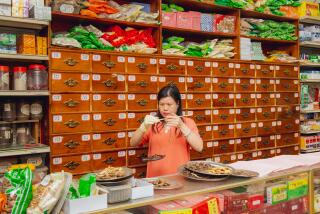Destination: New York : Big Apple Dynasty : Open-air markets, herbalists, Buddhist temples and exotic foods give Chinatown its mark of authenticity
- Share via
NEW YORK — If you’d like to go to China, there’s no place like New York. A combination of ferries, buses and subways can take modern-day Marco Polos to a Ming Dynasty garden retreat, a teeming neighborhood powered by ginseng and green tea or a Tibetan temple high on a hilltop . . . all without leaving the city.
Because any visit to China is a total-immersion experience, the best bet is to jump right in. Hop in a taxi to Chinatown, at Canal and Mott streets, or take a Lexington Avenue subway to Canal Street, then climb the dark and dingy stairs to the bright lights of Chinatown.
Some folks think of this maze of twisting streets as little more than restaurant row, and there’s probably no other place in the city where you can eat so many exotic foods for such reasonable prices.
But Chinatown is more than a neighborhood-wide buffet. It’s a community, where the faithful worship in Buddhist temples, the hopeful seek well-being in herb shops and homemakers shop in open-air markets like those you might see in, well, China.
The foreign atmosphere is pervasive. Mandarin characters emblazon nearly all the signs, even the street signs. On some byways, you may not see a single Westerner; in bookstores, newsstands and video emporiums you may not find one title in English.
Stroll down Mulberry Street, where the air is filled with the zing of butchers’ band saws, the shouts of fishmongers and smells almost too strange to contemplate. The shelves and tables groan with exotic comestibles: bags of jellyfish, jars of edible bird’s nests, some selling for as much as $1,840 per pound, cartons of quail eggs and boxes of chrysanthemum tea. Then there are the heaps and sprawls of produce--you might even see a spiky durian, the fabled stinky fruit of Southeast Asia.
*
One block over, on Mott Street, you can learn about tea at Ten Ren Tea and Ginseng Co. One side of the long narrow shop is lined with buttery colored metal urns brimming with teas from Taiwan: oolongs, jasmines and roses. These days the hot tea, so to speak, is green. I found the best of the lot to be King’s Tea Green, which runs about $130 a pound. If things are quiet, purchase a sample (perhaps of a more modest blend) and have the attendants brew a cup on the spot. While you’re sipping, they’ll introduce you to its subtleties and explain its nuances.
Just down the street at Kam Tat Inc., herbalist Grace Ho can be found sorting and preparing exotic plant and animal products. Amid heaps of ginseng, bags of dried sea horses, bottles of shark cartilage and boxes of sliced deer antlers, she crafts remedies for everything from impotence to high-blood pressure. The aim of all her medicines, she says, is to balance the body’s yin and yang and to enhance its chi, the invisible energy force we know as the immune system.
Some of Chinatown’s residents attend to their well-being in Buddhist temples. There’s one at 16 Pell St. and another on Mott. Both are low-key storefront affairs where prayerful worshipers bow before statues of Buddha in rooms flickering with lamps fueled by Mazola corn oil.
One of Chinatown’s odder stops is the Chinatown Fair Arcade, where you can see the “World Famous Dancing and Tic-Tac-Toe Chickens.” Inside this dark arcade, in one dim booth hidden among video games such as Mortal Kombat and Punch-Out, you’ll see a crude sign: “Bird Brain! Can You Beat Him?” Inside, a white chicken stands ready to challenge all comers in a game of tick-tack-toe. The chicken usually wins.
Just down the way is a big red box done up like a dime-store temple. It contains the Dancing Chicken, which, when last seen, was sitting one out. Its circular stage stood empty. Apparently the hen rarely two-steps anymore.
“It’s too old,” explained the arcade’s black T-shirted attendant. “It’s been here nine years.”
Not far away, at Chatham Square, a pigeon-fouled statue of Confucius surveys this hectic little corner of transplanted China.
A more contemplative piece of the old country can be reached on the Lexington Avenue subway. Several blocks southwest of the 86th Street station, in the Metropolitan Museum of Art, stands Astor Court, a re-created Ming-era scholar’s garden. But make sure you go soon. The garden will close in April for renovation of surrounding galleries and will remain closed until June, 1996.
This peaceful enclave amid the museum’s collection of Asian jades, Chinese scrolls, Japanese woodblock prints and countless sculptures and busts of Buddha is reached through a circular doorway called a moon gate, which is guarded by a pair of snarling guardian beasts. Once you’ve passed beneath the plaque inscribed with the Mandarin characters for “in search of quietude,” you enter a realm like that enjoyed by Ming scholars, who typically retired early from bureaucratic careers to spend the rest of their lives writing, teaching or building gardens.
The garden at the Met re-creates a courtyard from the Garden of the Master of the Fishing Nets, the Suzhou, China, retreat of Song Zonghuan, who purchased land in that city in 1760.
It’s not a traditional garden lush with plants. Instead, there are formations built of eerily eroded, perforated chunks of limestone. The stones seem to echo the landscapes depicted in some of the scroll paintings hanging in nearby galleries. Some of the rocks rise from tiny gardens decorated with mosses, orchids and blooming chrysanthemums.
Beside the miniature mountains runs a gurgling streamlet, splashing into a pool carpeted with black, algaed pebbles and alive with goldfish.
Here in the courtyard, like the one where Song Zonghuan contemplated the rising full moon or penned a few verses of poetry, a gaze toward the heavens reveals streaming clouds and a blazing sun, though an overhead pyramid of glass protects this garden from the onslaught of the elements.
Along the walls, there is a doglegging walkway, colonnaded with pillars made of a cedar glowing with the deep rich tone of maple syrup. Windows--each covered with a distinctive and different lattice--open onto views of plants such as bamboo, evergreen and quince. Here and there, corners of tile-roofed pavilions jut into the garden, creating an illusion that this small courtyard is part of a much greater whole. The eaves of the pavilion roofs are upswept as exuberantly as the toes of a court jester’s slippers.
To one side stands a richly stylized sitting room, separated from the garden by a beautiful wood lattice. The room, built of stout pillars and sleek beams, was constructed following a design in a Ming garden building manual dating to the 1600s.
The Met garden, an oasis of calm and quiet in the frenetic city, may seem just the spot for a few meditative moments, but the most tranquil Chinese stronghold--the Jacques Marchais Center of Tibetan Art--is farther away still.
From the Met, it requires a subway ride, a voyage across Upper New York Bay on the Staten Island Ferry, a 30-minute bus ride to Lighthouse Hill and, from there, a 10-minute uphill walk. Finally, the pilgrim arrives at the long, low stone wall enclosing what is essentially a Himalayan-style temple transplanted to the suburbs of Staten Island.
Tibet, of course, is not really Chinese, even though the country has been dominated for more than 40 years by its sprawling neighbor to the north. In fact, China has subjected Tibet and its people to brutal repression in an attempt to destroy the country’s indigenous culture. The country has established a sort of government in exile in Dharmsala, India, and Tibetans have immigrated to countries throughout the world. Hundreds live in California.
There’s nary a hint of that ongoing struggle inside the museum. The highlight is a trip into the dark stone gompa, or temple, where an array of Tibetan art--sculpted Buddhas, fearsome masks, large scroll paintings called thangkas and esoterica such as a vest of carved human bones--creates a potent spiritual tableau.
The many pieces on display come from the collection of Jacqueline Klauber, a Midwestern-born dealer in Asian art who presumably thought she’d do better with a more distinctive name and so changed hers to Jacques Marchais. Whatever her name, Tibetans might have recognized the woman as a reincarnated Tibetan. That would explain her enduring fascination with Tibet, a country she never visited.
Instead of visiting, she brought Tibet home to New York. From 1945 to 1947 she oversaw the construction of two stone-temple-like buildings to house her extensive collection. Marchais died shortly after opening the buildings to the public.
Today, this Tibet in miniature not only displays the art of that high Himalayan culture, but it also educates visitors on Tibetan Buddhism and hosts lectures and cultural events.
Just outside the museum stands a small sculpture-filled garden devoted in part to Himalayan plants. A tiny lotus pond lies at the bottom of a sharp drop-off. Prayer flags snap in the wind. Looking out from the hilltop terrace, the view is remarkably pastoral. There’s hardly a house or building in sight, just a sea of trees. It’s almost as if you were somewhere other than New York. Tibet, maybe.
(BEGIN TEXT OF INFOBOX / INFOGRAPHIC)
GUIDEBOOK
China in New York
Getting there: From LAX fly nonstop to New York on United, American, TWA, Tower Air or USAir for $298 round trip.
Chinatown: New York’s Chinatown is bounded roughly by Canal Street, the Bowery, Lafayette Street and Worth Street. The Lexington Avenue subway stop on Canal Street deposits riders a few blocks west of Mott Street, the neighborhood’s main thoroughfare.
Ten Ren Tea and Ginseng Co., 75 Mott St.; (212) 349-2286.
Kam Tat Inc., 54 Mott St.; (212) 925-8868.
Jacques Marchais Center of Tibetan Art: To get to the museum, go to Battery Park in Manhattan (take the subway to South Ferry), and take the Staten Island Ferry to Staten Island. From the ferry terminal, take bus S74. Ask the driver for the Lighthouse Avenue stop. Get off the bus, turn right and continue up the hill to the museum at 338 Lighthouse Ave. Allow 1 1/2 hours of travel time from midtown Manhattan. Or rent a car and drive there: Take the Verrazano Narrows Bridge west, onto Interstate 278 west, exit at Richmond Road/Clove Road; turn left onto Richmond Road and continue for about five miles to Lighthouse Avenue. Turn right onto Lighthouse and follow road to crest of the hill. Museum is open Wednesdays through Sundays from 1 to 5 p.m., April through November. (It’s closed this winter for renovation.) Admission to the museum and gardens is $3 for adults, $2.50 for seniors and $1 for children. Information: (718) 987-3500.
Metropolitan Museum of Art: The musuem is at Fifth Avenue and 82nd Street. Hours: 9:30 a.m. to 5:15 p.m. Tuesdays through Thursdays and Sundays; 9:30 a.m. to 8:45 p.m. Fridays and Saturdays. The Astor Court scholar’s garden will close in April for renovation of surrounding galleries. It will remain closed until June 1996. Information: (212) 879-5500. Admission prices are $7 for adults, $3.50 for students and seniors 65 and over, free for children under 12.
For more information: Discover NY, Box 992, Latham 12110, (800) 225-5697 or (518) 474-4116.
More to Read
Sign up for The Wild
We’ll help you find the best places to hike, bike and run, as well as the perfect silent spots for meditation and yoga.
You may occasionally receive promotional content from the Los Angeles Times.






